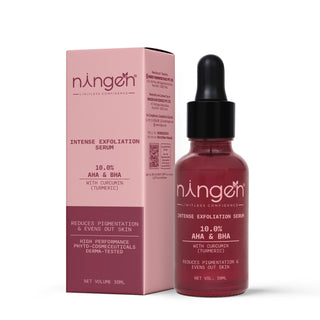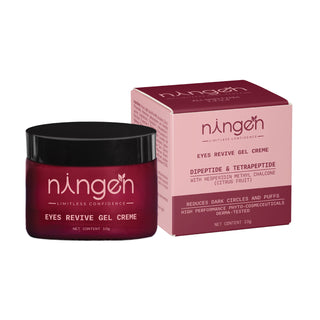Have you heard about Salicylic Acid?
Salicylic acid is a powerful ingredient commonly found in skincare products, especially for those with oily or acne-prone skin. Known for its ability to exfoliate and clear pores, it helps reduce acne, blackheads, and whiteheads. In this blog, we will explore what salicylic acid is, its benefits, and how to use it in your skincare routine for healthier, clearer skin.
In This Article;
- What is Salicylic Acid?
- Benefits of Salicylic Acid for Skin
- When to Apply in Your Daily Skincare Routine
- How to Apply in Your Daily Skincare Routine
- Precautions For Safe And Effective Use
- Is Salicylic Acid Safe for All Skin Types?
- Can Salicylic Acid Cause Skin Irritation?
- How Long Does it Take to See Results With Salicylic Acid?
- Final Thoughts
- TL;DR(Too Long; Didn't Read)
- Frequently Asked Questions
What is Salicylic Acid?
Salicylic acid is a beta-hydroxy acid (BHA) that is well-recognized for its effectiveness in skincare. Derived from willow bark, this active ingredient is a chemical exfoliant that helps remove dead skin cells. It penetrates deeply into the skin to dissolve the debris that clogs pores, making it highly effective for those with oily and acne-prone skin.
Unlike Alpha Hydroxy Acids (AHAs) which are water-soluble, salicylic acid is oil-soluble, allowing it to exfoliate within the pore lining. Regular use can result in a clearer complexion by encouraging skin cell turnover and reducing the appearance of dark spots and bumpy skin.

Note: What is Hydroxy Acid?
Hydroxy acids are a group of organic compounds commonly used in skincare products for their exfoliating properties. There are two main types of hydroxy acids: alpha-hydroxy acids (AHAs) and beta-hydroxy acids (BHAs).
Benefits of Salicylic Acid for Skin
Salicylic acid is a type of beta-hydroxy acid (BHA). It works by penetrating deep into your skin and exfoliating from within. Here’s a detail of how it helps your skin:
Clears Acne
- Unclogs Pores: Salicylic acid penetrates the skin and breaks down the bonds between dead skin cells. This process helps to clear out clogged pores, which is a common cause of acne. By keeping the pores clean and free from blockages, salicylic acid reduces the occurrence of pimples and breakouts.
- Reduces Inflammation: It has anti-inflammatory properties that help to reduce the redness and swelling associated with acne, providing relief and a clearer complexion.
Exfoliates
- Removes Dead Skin Cells: Unlike physical exfoliants that can sometimes be harsh and abrasive, salicylic acid gently exfoliates the skin by dissolving the outer layer of dead skin cells. This promotes the regeneration of new, healthy skin cells, leading to a smoother and more even skin surface.
- Promotes Cell Turnover: Regular use of salicylic acid encourages faster cell turnover, which can help to fade acne scars and improve overall skin texture.
Reduces Blackheads
- Penetrates Deep into Pores: Salicylic acid is oil-soluble, allowing it to penetrate deep into the skin’s pores. Once inside, it dissolves the oil and debris that can cause blackheads and whiteheads. This deep-cleaning action helps to prevent the formation of these common skin blemishes.
- Minimizes Pore Size: By keeping the pores clean and unclogged, salicylic acid can also help to reduce the appearance of large pores over time.
Prevents Future Breakouts
- Keeps Pores Clear: By continuously removing excess oil and dead skin cells, salicylic acid prevents the buildup of debris that can lead to clogged pores and subsequent breakouts. This proactive approach helps maintain clearer skin.
- Reduces Inflammation: Its anti-inflammatory properties not only help with existing acne but also prevent the skin from becoming overly irritated, which can lead to future breakouts.
Improves Skin Texture
- Promotes Even Skin Tone: Salicylic acid helps to fade dark spots and hyperpigmentation by exfoliating the skin and promoting cell turnover. This results in a more even skin tone and brighter complexion.
- Smoothes Skin: Regular use of salicylic acid can significantly improve the overall texture of the skin, making it feel smoother and softer. It helps to reduce the roughness and unevenness that can come with acne-prone skin.
When to Apply in Your Daily Skincare Routine
Salicylic Acid, a popular beta-hydroxy acid derived from willow bark, is an effective ingredient for managing several skin conditions, particularly those linked with oily and acne-prone skin. It penetrates the outer layer, promoting skin cell turnover and dissolving dead cells, thus assisting in clearing clogged pores. To harness its benefits correctly, follow these steps:
- Start by opting for a salicylic acid cleanser for daily use. Gently massage it onto damp skin, then rinse thoroughly.
- Integrate a salicylic acid serum sparingly in your routine, as it's more concentrated. Apply to clean, dry skin.
- Use spot treatments with higher concentrations only on targeted areas to avoid over-irritating the skin.
- Balance your regimen with a moisturizer, as hydroxy acids can dry out the skin.
- Apply sunscreen daily, as salicylic acid may increase sun sensitivity.
Remember to implement salicylic acid products gradually, especially if you have sensitive skin. Discontinue use and consult a dermatologist if you experience skin irritation or an allergic reaction. Lastly, pairing salicylic acid with Alpha Hydroxy Acids (AHAs) like lactic acid might lead to adverse reactions; it's crucial to not mix chemical exfoliants without professional guidance.
How to Apply in Your Daily Skincare Routine
Salicylic acid, a beta-hydroxy acid derived from willow bark, is particularly beneficial for acne-prone and oily skin types due to its ability to penetrate clogged pores. It is known for promoting skin cell turnover and removing dead skin cells, which can help reduce the appearance of dark spots and improve skin texture.
When incorporating salicylic acid into a daily skincare routine, it is commonly found in the form of cleansers, serums, or spot treatments. Ideally, salicylic acid products should be applied after cleansing but before moisturizing. Here’s a simple step-by-step guide:
- Cleanse: Start with a gentle cleanser to remove makeup and impurities.
- Tone: Apply a toner if it is part of your routine.
- Salicylic acid application: Use the salicylic acid product as directed. For serums spot treatments, or creams.
- Moisturize: Hydrate your skin to lock in moisture.
- Sun Protection (AM routine): Finish with a broad-spectrum sunscreen during the day.
Since salicylic acid is a chemical exfoliant, introduce it gradually to prevent skin irritation. Beginning with applications every other day can allow the skin to adjust. Monitor for signs of dry skin or an allergic reaction, and discontinue use if adverse reactions occur. Always follow product-specific instructions and consider consulting a dermatologist to tailor it to your individual skin needs.
Also read: How to remove dark spots caused by pimples on face.
Precautions For Safe And Effective Use
Salicylic acid can be a powerful ingredient for addressing a range of skin conditions, particularly those involving clogged pores and excess sebum. However, to ensure safe and effective use, there are precautions you should consider:
- Patch Test: Before full application, perform a patch test to check for any allergic reaction.
- Concentration: Use products with an appropriate concentration of salicylic acid for your skin type. Over-the-counter products typically range from 0.5% to 2%.
- Frequency: Start by applying salicylic acid products every other day or less, gradually increasing if tolerated.
- Sun Exposure: Salicylic acid can make your skin more sensitive to the sun. Wear sunscreen and limit sun exposure while using these products.
- Avoid Sensitive Areas: Do not apply salicylic acid on sensitive skin areas, such as around the eyes or mouth, or on broken skin.
Note: Read our other article on blackheads,
Is Salicylic Acid Safe for All Skin Types?
Salicylic acid is generally considered safe for most skin types, but it is particularly beneficial for oily and acne-prone skin due to its ability to dissolve excess sebum and dead cells. For sensitive skin or dry skin types, salicylic acid should be used with caution as it may lead to irritation or dryness. People with extremely sensitive skin or eczema may want to avoid salicylic acid altogether. It's always best to start with a lower concentration and patch test before full use. It is best to consult with a dermatologist who can provide guidance tailored to one's skin concerns.
Can Salicylic Acid Cause Skin Irritation?
Yes, salicylic acid can cause skin irritation, particularly when it is used in higher concentrations or more frequently than recommended. Signs of skin irritation can include:
- Redness
- Peeling
- Burning or stinging sensation
- Dryness
- Itching
If you experience severe or persistent irritation, discontinue use and seek advice from a healthcare provider. Additionally, using a moisturizer alongside salicylic acid products can help minimize irritation.
How Long Does it Take to See Results With Salicylic Acid?
Results with salicylic acid can vary based on the condition being treated and individual skin types. When used for mild to moderate acne, some improvements may be seen in as little as one week, but it generally takes several weeks of consistent use to see notable results. For conditions such as bumpy skin or dark spots, improvements might take a few weeks to a couple of months. For the best outcome, it’s important to establish a consistent daily routine and allow time for your skin to gradually respond to the treatment.
On initiating use of salicylic acid products, like a salicylic acid cleanser, serum, or spot treatment, some individuals might notice immediate improvement in the texture and clarity of their skin. However, for observable changes in acne and dark spots, it can take several weeks to see the full benefits. The table below denotes a general expectation for visible results:
|
Timeline |
Expected Results |
|
Immediate to 1 week |
Smoother skin texture |
|
2-4 weeks |
Reduced bumpy skin |
|
4-6 weeks |
Clearer skin, less acne |
|
8-12 weeks |
Diminished dark spots |
It's important to integrate salicylic acid gradually into your skincare regimen to minimize adverse reactions, and it's recommended to use sunscreen since hydroxy acids can make your skin more sensitive to the sun. Seeking advice from a dermatologist is advised for those with sensitive or dry skin, as well as if any allergic reactions or skin irritation occurs.
Final Thoughts
Hope you find our article and got to know salicylic Acid better. Clear pores, smoother skin, and fewer breakouts – that's the magic of salicylic acid. Continuous use of salicylic acid products, such as salicylic acid cleansers, serums, or spot treatments, can result in clearer, smoother skin. It is crucial to integrate it gradually into skincare routines to minimize the risk of skin irritation. Despite its benefits, individuals with sensitive or dry skin should use the ingredient with caution to prevent adverse reactions. In the case of any skin irritation or suspected allergic reaction, it is advisable to consult a healthcare provider.
Quick view
Salicylic acid, a powerful beta-hydroxy acid derived from willow bark, is effective for oily and acne-prone skin. It exfoliates, and unclogs pores, reduces acne and blackheads, and improves skin texture. Regular use of salicylic acid products, such as cleansers, serums, and spot treatments, can lead to clearer and smoother skin. It's essential to start with lower concentrations and integrate it gradually into your skincare routine, using sunscreen to prevent sun sensitivity. Consult a dermatologist if you have sensitive skin or experience irritation.
Frequently Asked Questions
Q1. What is salicylic acid?
Salicylic acid is a beta-hydroxy acid (BHA) derived from willow bark, commonly used in skincare products for its exfoliating and acne-fighting properties.
Q2. How does salicylic acid benefit the skin?
It unclogs pores, reduces acne, exfoliates dead skin cells, diminishes blackheads, and improves overall skin texture.
Q3. Is salicylic acid safe for all skin types?
Salicylic acid is generally safe for most skin types but is particularly beneficial for oily and acne-prone skin. People with sensitive or dry skin should use it with caution.
Q4. How should I start using salicylic acid in my skincare routine?
Begin with a lower concentration and use it every other day, gradually increasing frequency if your skin tolerates it well. Always follow with a moisturizer and sunscreen.
Q5. Can I use salicylic acid with other skincare products?
Avoid using salicylic acid with other strong chemical exfoliants like AHAs to prevent over-exfoliation. Always patch test when introducing new products.
Q6. What are the potential side effects of salicylic acid?
Possible side effects include redness, peeling, dryness, and irritation. If you experience severe reactions, discontinue use and consult a dermatologist.
Q7. How long does it take to see results with salicylic acid?
While some improvements in texture may be seen immediately, noticeable results for acne and dark spots typically take several weeks of consistent use.
Q8. Can salicylic acid cause sun sensitivity?
Yes, salicylic acid can increase sun sensitivity. It's crucial to use sunscreen daily when incorporating salicylic acid into your routine.
Q9. What is the difference between salicylic acid and AHAs?
Salicylic acid (BHA) is oil-soluble and penetrates deeper into the pores, making it ideal for oily and acne-prone skin. AHAs are water-soluble and work on the skin's surface to exfoliate and improve texture.
Q10. What concentration of salicylic acid should I use?
Over-the-counter products typically range from 0.5% to 2%. Start with a lower concentration and increase as needed, depending on your skin's tolerance.











